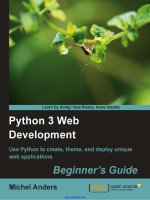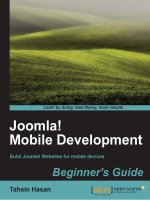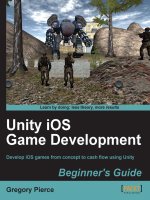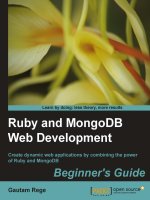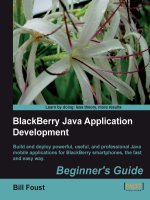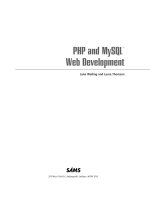PHP and MongoDB Web Development Beginner''''s Guide pptx
Bạn đang xem bản rút gọn của tài liệu. Xem và tải ngay bản đầy đủ của tài liệu tại đây (4.47 MB, 292 trang )
PHP and MongoDB
Web Development
Beginner's Guide
Combine the power of PHP and MongoDB to build
dynamic web 2.0 applicaons
Rubayeet Islam
BIRMINGHAM - MUMBAI
PHP and MongoDB Web Development
Beginner's Guide
Copyright © 2011 Packt Publishing
All rights reserved. No part of this book may be reproduced, stored in a retrieval system,
or transmied in any form or by any means, without the prior wrien permission of the
publisher, except in the case of brief quotaons embedded in crical arcles or reviews.
Every eort has been made in the preparaon of this book to ensure the accuracy of the
informaon presented. However, the informaon contained in this book is sold without
warranty, either express or implied. Neither the author, nor Packt Publishing, and its dealers
and distributors will be held liable for any damages caused or alleged to be caused directly
or indirectly by this book.
Packt Publishing has endeavored to provide trademark informaon about all of the companies
and products menoned in this book by the appropriate use of capitals. However, Packt
Publishing cannot guarantee the accuracy of this informaon.
First published: November 2011
Producon Reference: 1181111
Published by Packt Publishing Ltd.
Livery Place
35 Livery Street
Birmingham B3 2PB, UK.
ISBN 978-1-84951-362-3
www.packtpub.com
Cover Image by Charwak A ()
Credits
Author
Rubayeet Islam
Reviewers
Sam Millman
Sigert de Vries
Nurul Ferdous
Vidyasagar N V
Acquision Editor
Usha Iyer
Development Editor
Susmita Panda
Technical Editors
Joyslita D'Souza
Veronica Fernandes
Lubna Shaikh
Copy Editor
Laxmi Subramanian
Project Coordinator
Kushal Bhardwaj
Proofreader
Mahew Humphries
Indexer
Tejal Daruwale
Graphics
Valenna D'silva
Producon Coordinator
Prachali Bhiwandkar
Cover Work
Prachali Bhiwandkar
About the Author
Rubayeet Islam is a Soware Developer with over 4 years of experience in large-scale
web applicaon development on open source technology stacks (LAMP, Python/Django,
Ruby on Rails). He is currently involved in developing cloud-based distributed soware that
use MongoDB as their analycs and metadata backend. He has also spoken in seminars
to promote the use of MongoDB and NoSQL databases in general. He graduated from the
University of Dhaka with a B.S. in Computer Science and Engineering.
I thank the Almighty for giving me such a blessed life and my parents for
leng me follow my passion. My friend and colleague, Nurul Ferdous, for
inspiring me to be an author in the rst place. Finally, the amazing people
at Packt – Usha Iyer, Kushal Bhardwaj, Priya Mukherji, and Susmita Panda,
without your help and guidance this book would not have been possible
to write.
About the Reviewers
Sam Millman, aer achieving a B.Sc. in Compung from the University of Plymouth,
immediately moved to advance his knowledge within Web development, specically PHP. He
is a fully self-taught professional Web Developer and IT Administrator working for a company
in the south of England.
He rst started to show an interest in MongoDB when he went in search of something
new to learn. Now he is an acve user of the MongoDB Google User Group and is about to
release a new site wrien in PHP with MongoDB as the primary data store.
Sigert de Vries (1983) is a professional Web Developer working in The Netherlands. He has
worked in several companies as a System Administrator and Web Developer. He is a specialist
in high performance websites and is an open source enthusiast. With his communicave
skills, he translates advanced technical issues to "normal" human language.
Sigert is currently working at
Worldticketshop.com, helping them to be one of the largest
cket marketplaces in Europe. Within the company, there's plenty of room to use NoSQL
soluons such as MongoDB.
I would like to thank Packt publishing for asking me to review this book, it
has been a pleasure!
Vidyasagar N V was interested in Computer Science since an early age. Some of his serious
work in computers and computer networks began during his high school days. Later, he went
to the presgious Instute Of Technology, Banaras Hindu University for his B.Tech. He has
been working as a Soware Developer and Data Expert, developing and building scalable
systems. He has worked with a variety of 2nd, 3rd, and 4th generaon languages. He has
worked with at les, indexed les, hierarchical databases, network databases, relaonal
databases, NoSQL databases, Hadoop, and related technologies. Currently, he is working
as a Senior Developer at Ziva Soware Pvt. Ltd., developing big database-structured data-
extracon techniques for the Web and local informaon. He enjoys producing high-quality
soware, web-based soluons, and designing secure and scalable data systems.
I would like to thank my parents, Mr. N Srinivasa Rao and Mrs.Latha Rao,
and my family who supported and backed me throughout my life. My
friends for being friends, and all those people willing to donate their me,
eort, and experse by parcipang in open source soware projects.
Thank you Packt Publishing for selecng me as one of the technical
reviewers on this wonderful book. It is my honor to be a part of this book.
You can contact me at
www.PacktPub.com
Support les, eBooks, discount offers and more
You might want to visit www.PacktPub.com for support les and downloads related to
your book.
Did you know that Packt oers eBook versions of every book published, with PDF and ePub
les available? You can upgrade to the eBook version at
www.PacktPub.com and as a print
book customer, you are entled to a discount on the eBook copy. Get in touch with us at
for more details.
At
www.PacktPub.com, you can also read a collecon of free technical arcles, sign up for
a range of free newsleers and receive exclusive discounts and oers on Packt books and
eBooks.
Do you need instant soluons to your IT quesons? PacktLib is Packt's online digital book
library. Here, you can access, read and search across Packt's enre library of books.
Why Subscribe?
• Fully searchable across every book published by Packt
• Copy and paste, print and bookmark content
• On demand and accessible via web browser
Free Access for Packt account holders
If you have an account with Packt at www.PacktPub.com, you can use this to access
PacktLib today and view nine enrely free books. Simply use your login credenals for
immediate access.
Table of Contents
Preface 1
Chapter 1: Geng Started with MongoDB 7
The NoSQL movement 8
Types of NoSQL databases 8
MongoDB – A document-based NoSQL database 9
Why MongoDB? 9
Who is using MongoDB? 9
MongoDB concepts—Databases, collecons, and documents 10
Anatomy of document 10
BSON—The data exchange format for MongoDB 11
Similarity with relaonal databases 11
Downloading, installing, and running MongoDB 12
System requirements 12
Time for acon – downloading and running MongoDB on Windows 13
Installing the 64-bit version 14
Time for acon – downloading and running MongoDB on Linux 15
Installing MongoDB on OS X 17
Conguring MongoDB 17
Command-line parameters 17
File-based conguraon 18
Stopping MongoDB 18
Hing Control + C 18
From the mongo shell 19
Sending INT or TERM signal in UNIX 19
Creang databases, collecons, and documents 19
Time for Acon – creang databases, collecons, and documents 19
Installing the PHP driver for MongoDB 21
Time for Acon – installing PHP driver for MongoDB on Windows 21
Installing the PHP-MongoDB driver on Unix 23
Table of Contents
[ ii ]
Connecng to the MongoDB server from PHP 23
Creang a PHP-Mongo connecon 23
Time for acon – creang a connecon to the MongoDB server from PHP 24
Conguring the PHP-MongoDB connecon 26
Specifying meout for the connecon aempt 26
Summary 27
Chapter 2: Building your First MongoDB Powered Web App 29
A MongoDB powered blog 30
Have the MongoDB server running 30
Inserng documents in MongoDB 30
Time for acon – building the Blog Post Creator 30
Creang databases and collecons implicitly 35
Performing 'safe' inserts 35
Benets of safe inserts 36
Specifying a meout on insert 36
Seng the user generated _id 37
The MongoDate object 37
Querying documents in a collecon 38
Time for acon – retrieving arcles from a database 38
The Mongo Query Language 42
The MongoCursor object 42
Condional Queries 44
Doing advanced queries in MongoDB 45
Time for acon – building the Blog Dashboard 45
Returning a subset of elds 49
Sorng the query results 49
Using count, skip, and limit 49
Performing range queries on dates 50
Updang documents in MongoDB 51
Time for acon – building the Blog Editor 51
Oponal arguments to the update method 55
Performing 'upsert' 55
Using update versus using save 56
Using modier operaons 56
Seng with $set 56
Incremenng with $inc 57
Deleng elds with $unset 57
Renaming elds with $rename 57
Deleng documents in MongoDB 58
Time for acon – deleng blog posts 58
Oponal arguments to remove 63
Table of Contents
[ iii ]
Managing relaonships between documents 63
Embedded documents 64
Referenced documents 64
Time for acon – posng comments to blog posts 64
Embedded versus referenced – Which one to use? 69
Querying embedded objects 69
Summary 71
Chapter 3: Building a Session Manager 73
Understanding HTTP sessions 74
Understanding PHP nave session handling 74
Time for acon – tesng nave PHP session handling 74
Limitaons of nave PHP session handling 78
Implemenng session handling with MongoDB 78
Extending session handling with session_set_save_handler 78
The SessionManager class 79
Time for acon – building the SessionManager class 79
How the SessionManager works 83
The constructor 83
The open and close methods 84
The read method 84
The write method 84
The destroy method 84
The gc method 85
Pung the SessionManager in acon 85
Time for acon – pung SessionManager into acon 86
Building the user authencaon module 88
Time for acon – building the User class 89
Creang the login, logout, and user prole page 92
Time for acon – creang the login, logout, and prole page 93
Using good session pracces 99
Seng low expiry mes of session cookies 99
Using session meouts 100
Seng proper domains for session cookies 100
Checking for browser consistency 100
Summary 101
Chapter 4: Aggregaon Queries 103
Generang sample data 104
Time for acon – generang sample data 104
Understanding MapReduce 107
Visualizing MapReduce 108
Performing MapReduce in MongoDB 109
Table of Contents
[ iv ]
Time for acon – counng the number of arcles for each author 110
Dening the Map funcon 111
Dening the Reduce funcon 112
Applying the Map and Reduce 112
Viewing the results 113
Performing MapReduce on a subset of the collecon 114
Concurrency 114
Performing MongoDB MapReduce within PHP 114
Time for acon – creang a tag cloud 115
Performing aggregaon using group() 120
Time for acon – calculang the average rang per author 121
Grouping by custom keys 124
MapReduce versus group() 124
Lisng disnct values for a eld 125
Time for acon – lisng disnct categories of arcles 125
Using disnct() in mongo shell 127
Counng documents with count() 127
Summary 128
Chapter 5: Web Analycs using MongoDB 129
Why MongoDB is a good choice as a web analycs backend 130
Logging with MongoDB 131
Time for acon – logging page visits with MongoDB 131
Capped collecons 134
Sorng in natural order 135
Updang and deleng documents in a capped collecon 135
Specifying the size of a regular collecon 135
Convert a regular collecon to a capped one 136
Extracng analycs data with MapReduce 136
Time for acon – nding total views and average response me per blog post 137
The map, reduce, and nalize funcons 140
Displaying the result 140
Running MapReduce in real me versus running it in the background 141
Real-me analycs using MongoDB 141
Time for acon – building a real-me page visit counter 141
Summary 146
Chapter 6: Using MongoDB with Relaonal Databases 147
The movaon behind using MongoDB and an RDBMS together 148
Potenal use cases 148
Dening the relaonal model 149
Time for acon – creang the database in MySQL 150
Table of Contents
[ v ]
Caching aggregaon results in MongoDB 153
Time for acon – storing the daily sales history of products in MongoDB 153
Benets of caching queries in MongoDB 160
Storing results of expensive JOINs 160
Using MongoDB for data archiving 160
Time for acon – archiving old sales records in MongoDB 161
Challenges in archiving and migraon 163
Dealing with foreign key constraints 163
Preserving data types 163
Storing metadata in MongoDB 164
Time for acon – using MongoDB to store customer metadata 164
Problems with using MongoDB and RDBMS together 173
Summary 173
Chapter 7: Handling Large Files with GridFS 175
What is GridFS? 175
The raonale of GridFS 176
The specicaon 176
Advantages over the lesystem 177
Storing les in GridFS 178
Time for acon – uploading images to GridFS 178
Looking under the hood 181
Serving les from GridFS 182
Time for acon – serving images from GridFS 183
Updang metdata of a le 186
Deleng les 186
Reading les in chunks 187
Time for acon – reading images in chunks 187
When should you not use GridFS 189
Summary 190
Chapter 8: Building Locaon-aware Web Applicaons with
MongoDB and PHP 191
A geolocaon primer 192
Methods to determine locaon 192
Detecng the locaon of a web page visitor 193
The W3C Geolocaon API 193
Browsers that support geolocaon 194
Time for acon – detecng locaon with W3C API 194
The Geolocaon object 198
The getCurrentPosion() method 198
Drawing the map using the Google Maps API 199
Table of Contents
[ vi ]
Geospaal indexing 200
Time for acon – creang geospaal indexes 201
Geospaal indexing – Important things to know 202
Performing locaon queries 203
Time for acon – nding restaurants near your locaon 203
The geoNear() command 208
Bounded queries 210
Geospaal haystack indexing 210
Time for acon – nding nearby restaurants that serve burgers 211
Summary 215
Chapter 9: Improving Security and Performance 217
Enhancing query performance using indexes 217
Time for acon – creang an index on a MongoDB collecon 218
The _id index 221
Unique indexes 221
Compound keys indexes 222
Indexing embedded document elds 223
Indexing array elds 224
Deleng indexes 224
When indexing cannot be used 224
Indexing guidelines 225
Choose the keys wisely 225
Keep an eye on the index size 225
Avoid using low-selecvity single key indexes 225
Be aware of indexing costs 226
On a live database, run indexing in the background 226
Opmizing queries 227
Explaining queries using explain() 227
Opmizaon rules 228
Using hint() 228
Proling queries 229
Understanding the output 229
Opmizaon rules 230
Securing MongoDB 230
Time for acon – adding user authencaon in MongoDB 230
Creang an admin user 232
Creang regular user 233
Viewing, changing, and deleng user accounts 233
User authencaon through PHP driver 234
Filtering user input 235
Running MongoDB server in a secure environment 235
Table of Contents
[ vii ]
Ensuring data durability 236
Journaling 236
Performance 237
Using fsync 237
Replicaon 238
Summary 239
Chapter 10: Easy MongoDB Administraon with RockMongo
and phpMoAdmin 241
Administering MongoDB with RockMongo 242
Time for acon – installing RockMongo on your computer 242
Exploring data with RockMongo 244
Querying 245
Updang, deleng, and creang documents 245
Imporng and exporng data 247
Viewing stats 248
Miscellaneous 248
Using phpMoAdmin to administer MongoDB 249
Time for acon – installing phpMoAdmin on your computer 249
Viewing databases and collecons 250
Querying documents 251
Saving and deleng objects 252
Imporng and exporng data 252
Viewing stats 253
Other features 253
RockMongo versus phpMoAdmin 254
The verdict 255
Summary 256
Pop Quiz Answers 257
Chapter 1, Geng Started with MongoDB 257
Chapter 2, Building your First MongoDB Powered Web App 257
Chapter 3, Building a Session Manager 258
Chapter 4, Aggregaon Queries 258
Chapter 5, Web Analycs using MongoDB 258
Chapter 7, Handling Large Files with GridFS 259
Chapter 8, Building Locaon-aware Web Applicaons with MongoDB and PHP 259
Chapter 9, Improving Security and Performance 259
Index 237
Preface
MongoDB is an open source, non-relaonal database system designed to meet the needs
of modern Web 2.0 applicaons. It is currently being used by some of the most popular
websites in the world. This book introduces MongoDB to the web developer who has some
background building web applicaons using PHP. This book teaches what MongoDB is, how
it is dierent from relaonal database management systems, and when and why developers
should use it instead of a relaonal database for storing data.
You will learn how to build PHP applicaons that use MongoDB as the data backend; solve
common problems, such as HTTP session handling, user authencaon, and so on.
You will also learn to solve interesng problems with MongoDB, such as web analycs with
MapReduce, storing large les in GridFS, and building locaon-aware applicaons using
Geospaal indexing.
Finally, you will learn how to opmize MongoDB to boost performance, improve security,
and ensure data durability. The book will demonstrate the use of some handy GUI tools
that makes database management easier.
What this book covers
Chapter 1, Geng Started with MongoDB introduces the underlying concepts of MongoDB,
provides a step-by-step guide on how to install and run a MongoDB server on a computer,
and make PHP and MongoDB talk to each other.
Chapter 2, Building your First MongoDB Powered Web App shows you how to build a simple
blogging web applicaon using PHP and MongoDB. Through the examples in this chapter,
you will learn how to create/read/update/delete data in MongoDB using PHP.
Chapter 3, Building a Session Manager shows you how PHP and MongoDB can be used to
handle HTTP sessions. You will build a stand-alone session manager module and learn how
to perform user authencaon/authorizaon using the module.
Preface
[ 2 ]
Chapter 4, Aggregaon Queries introduces MapReduce, a powerful funconal programming
paradigm and shows you how it can be used to perform aggregaon queries in MongoDB.
Chapter 5, Web Analycs using MongoDB shows you how you can store website trac data
in MongoDB in real me and use MapReduce to extract important analycs.
Chapter 6, Using MongoDB with Relaonal Databases explores use cases where MongoDB
can be used alongside a relaonal database. You will learn how to archive data in MongoDB,
use it for caching expensive query results, and store non-structured metadata about dierent
objects in the domain.
Chapter 7, Handling Large Files with GridFS introduces GridFS, a specicaon in MongoDB
that allows us to store large les in the database.
Chapter 8, Building Locaon-aware Web Applicaons with MongoDB and PHP, uses
PHP, HTML5, JavaScript, and the Geospaal Indexing feature of MongoDB to build a web
applicaon that helps you nd restaurants close to your current locaon.
Chapter 9, Improving Security and Performance shows you how to boost query performance
using indexes, use built-in tools for analyzing and ne-tuning queries, improve database
security, and ensure data durability.
Chapter 10, Easy MongoDB Administraon with RockMongo and phpMoAdmin demonstrates
the use of a couple of PHP-based GUI tools for managing MongoDB server—RockMongo and
phpMoAdmin.
What you need for this book
Apache web server (or IIS if you are on Windows) running PHP 5.2.6 or higher.
A web browser that supports the W3C Geolocaon API (Internet Explorer 9.0+, Google
Chrome 5.0+, Firefox 3.5+ or Safari 5.0+).
Chapter 6, Using MongoDB with Relaonal Databases requires that you have MySQL
installed on your machine.
Who this book is for
This book assumes that you have some background in web applicaon development using
PHP, HTML, and CSS. Some of the chapters require that you know JavaScript and are familiar
with AJAX. Having a working knowledge of using a relaonal database system, such as
MySQL will help you grasp some of the concepts quicker, but it is not strictly mandatory.
No prior knowledge of MongoDB is required.
Preface
[ 3 ]
Conventions
In this book, you will nd several headings appearing frequently.
To give clear instrucons of how to complete a procedure or task, we use:
Time for action – heading
1. Acon 1
2. Acon 2
3. Acon 3
Instrucons oen need some extra explanaon so that they make sense, so they are
followed with:
What just happened?
This heading explains the working of tasks or instrucons that you have just completed.
You will also nd some other learning aids in the book, including:
Pop quiz – heading
These are short mulple choice quesons intended to help you test your own understanding.
Have a go hero – heading
These set praccal challenges and give you ideas for experimenng with what you have
learned.
You will also nd a number of styles of text that disnguish between dierent kinds of
informaon. Here are some examples of these styles, and an explanaon of their meaning.
Code words in text are shown as follows: "The value for the rst eld,
_id, is
autogenerated."
A block of code is set as follows:
try {
$mongo = new Mongo($options=array('timeout'=> 100))
} catch(MongoConnectionException $e) {
die("Failed to connect to database ".$e->getMessage());
}
Preface
[ 4 ]
When we wish to draw your aenon to a parcular part of a code block, the relevant lines
or items are set in bold:
{
_id : ObjectId("4dcd2abe5981aec801010000"),
title : "The only perfect site is hind-site",
content : "Loren ipsum dolor sit amet…",
saved_at : ISODate('2011-05-16T18:42:57.949Z'),
author_id : ObjectId("4dd491695072aefc456c9aca")
}
Any command-line input or output is wrien as follows:
>db.movies.find({"genre":"sci-fi"})
{ "_id" : ObjectId("4db439153ec7b6fd1c9093ec"), "name" : "Source Code",
"genre" : "sci-fi", "year" : 2011 }
New terms and important words are shown in bold. Words that you see on the screen, in
menus or dialog boxes for example, appear in the text like this: "Click on the Delete link on
any one arcle."
Warnings or important notes appear in a box like this.
Tips and tricks appear like this.
Reader feedback
Feedback from our readers is always welcome. Let us know what you think about this
book—what you liked or may have disliked. Reader feedback is important for us to develop
tles that you really get the most out of.
To send us general feedback, simply send an e-mail to
, and
menon the book tle via the subject of your message.
If there is a book that you need and would like to see us publish, please send us a note in the
SUGGEST A TITLE form on
www.packtpub.com or e-mail
If there is a topic that you have experse in and you are interested in either wring or
contribung to a book, see our author guide on
www.packtpub.com/authors.
Preface
[ 5 ]
Customer support
Now that you are the proud owner of a Packt book, we have a number of things to help you
to get the most from your purchase.
Downloading the example code
You can download the example code les for all Packt books you have purchased from your
account at . If you purchased this book elsewhere, you can
visit
and register to have the les e-mailed directly
to you.
Errata
Although we have taken every care to ensure the accuracy of our content, mistakes do
happen. If you nd a mistake in one of our books—maybe a mistake in the text or the
code—we would be grateful if you would report this to us. By doing so, you can save
other readers from frustraon and help us improve subsequent versions of this book. If
you nd any errata, please report them by vising
selecng your book, clicking on the errata submission form link, and entering the details
of your errata. Once your errata are veried, your submission will be accepted and the
errata will be uploaded on our website, or added to any list of exisng errata, under the
Errata secon of that tle. Any exisng errata can be viewed by selecng your tle from
/>Piracy
Piracy of copyright material on the Internet is an ongoing problem across all media. At Packt,
we take the protecon of our copyright and licenses very seriously. If you come across any
illegal copies of our works, in any form, on the Internet, please provide us with the locaon
address or website name immediately so that we can pursue a remedy.
Please contact us at
with a link to the suspected pirated material.
We appreciate your help in protecng our authors, and our ability to bring you valuable
content.
Questions
You can contact us at if you are having a problem with any
aspect of the book, and we will do our best to address it.
1
Getting Started with MongoDB
We are about to begin our journey in PHP and MongoDB web development.
Since you picked up this book, I assume you have some background building
web apps using PHP, and you are interested in learning to develop PHP
applicaons with MongoDB as data backend. In case you have never heard
of MongoDB before, it is an open source, document-oriented database that
supports the concept of exible schema. In this chapter, we will learn what
MongoDB is, and what do we gain from using MongoDB instead of trusted
old SQL databases. We will start by learning briey about the NoSQL
databases (a set of database technologies that are considered alternave
to RDBM systems), the basics of MongoDB, and what disnguishes it from
relaonal databases. Then we will move on to installing and running
MongoDB and hooking it up with PHP.
To sum it up, in this chapter we will:
• Learn about the NoSQL movement
• Learn the basic concepts behind MongoDB
• Learn how to download, install, and run MongoDB on a computer
• Learn to use the
mongo Interacve Shell
• Learn how to make PHP and MongoDB talk to each other
So let's get on with it
Geng Started with MongoDB
[ 8 ]
The NoSQL movement
You probably have heard about NoSQL before. You may have seen it in the RSS feed
headlines of your favorite tech blogs, or you overheard a conversaon between developers
in your favorite restaurant during lunch. NoSQL (elaborated "Not only SQL"), is a data storage
technology. It is a term used to collecvely idenfy a number of database systems, which
are fundamentally dierent from relaonal databases. NoSQL databases are increasingly
being used in web 2.0 applicaons, social networking sites where the data is mostly user
generated. Because of their diverse nature, it is dicult to map user-generated content to a
relaonal data model, the schema has to be kept as exible as possible to reect the changes
in the content. As the popularity of such a website grows, so does the amount of data and
the read-write operaons on the data. With a relaonal database system, dealing with
these problems is very hard. The developers of the applicaon and administrators of the
database have to deal with the added complexity of scaling the database operaons, while
keeping its performance opmum. This is why popular websites—Facebook, Twier to name
a few—have adopted NoSQL databases to store part or all of their data. These database
systems have been developed (in many cases built from scratch by developers of the web
applicaons in queson!) with the goal of addressing such problems, and therefore are more
suitable for such use cases. They are open source, freely available on the Internet, and their
use is increasingly gaining momentum in consumer and enterprise applicaons.
Types of NoSQL databases
The NoSQL databases currently being used can be grouped into four broad categories:
• Key-value data stores: Data is stored as key-value pairs. Values are retrieved by keys.
Redis, Dynomite, and Voldemort are examples of such databases.
• Column-based databases: These databases organize the data in tables, similar to an
RDBMS, however, they store the content by columns instead of rows. They are good
for data warehousing applicaons. Examples of column-based databases are Hbase,
Cassandra, Hypertable, and so on.
• Document-based databases: Data is stored and organized as a collecon of
documents. The documents are exible; each document can have any number of
elds. Apache CouchDB and MongoDB are prominent document databases.
• Graph-based data-stores: These databases apply the computer science graph theory
for storing and retrieving data. They focus on interconnecvity of dierent parts
of data. Units of data are visualized as nodes and relaonships among them are
dened by edges connecng the nodes. Neo4j is an example of such a database.

